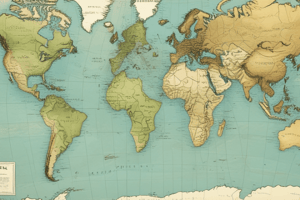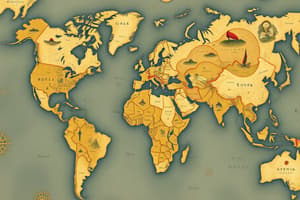Podcast
Questions and Answers
What is the definition of location in geography?
What is the definition of location in geography?
- The physical position of people and places on Earth’s surface. (correct)
- The relationship between global and local environments.
- The unique physical characteristics that define a region.
- The cultural characteristics of an area.
Which type of location refers to an exact position defined by coordinates?
Which type of location refers to an exact position defined by coordinates?
- Geographical location
- Relative location
- Absolute location (correct)
- Specific location
What are the two main types of location in geography?
What are the two main types of location in geography?
- Absolute and relative location (correct)
- Grid and virtual location
- Cultural and physical location
- Urban and rural location
What does the term 'place' encompass in geographical studies?
What does the term 'place' encompass in geographical studies?
Regions in geography can be defined by which characteristics?
Regions in geography can be defined by which characteristics?
How do geographers utilize the theme of movement?
How do geographers utilize the theme of movement?
Which of the following best describes the purpose of the theme of Human-Environment Interaction?
Which of the following best describes the purpose of the theme of Human-Environment Interaction?
What is one function of geography in relation to history?
What is one function of geography in relation to history?
What human activity is described as potentially detrimental to the environment?
What human activity is described as potentially detrimental to the environment?
Which geographical feature of Norway is known for being U-shaped valleys filled by the sea?
Which geographical feature of Norway is known for being U-shaped valleys filled by the sea?
What reason is cited for Welsh migration to England?
What reason is cited for Welsh migration to England?
Which term best describes the area that includes South Korea, Taiwan, and Hong Kong?
Which term best describes the area that includes South Korea, Taiwan, and Hong Kong?
Which of the following describes the relationship between tourism and local economy in Andorra?
Which of the following describes the relationship between tourism and local economy in Andorra?
Where is the Mariana Trench located?
Where is the Mariana Trench located?
What is a major economic feature of the Cotton Belt in the United States?
What is a major economic feature of the Cotton Belt in the United States?
What key question do geographers seek to answer regarding location?
What key question do geographers seek to answer regarding location?
What type of region is defined by official boundaries established by governments?
What type of region is defined by official boundaries established by governments?
Which type of region is organized around a central hub that supports its surrounding area?
Which type of region is organized around a central hub that supports its surrounding area?
Which of the following is NOT a characteristic of perceptual regions?
Which of the following is NOT a characteristic of perceptual regions?
How do human-environment interactions manifest in society?
How do human-environment interactions manifest in society?
What is one way humans have adapted to their environment?
What is one way humans have adapted to their environment?
Which of the following describes movement as studied by geographers?
Which of the following describes movement as studied by geographers?
Which theme focuses on the relationships between humans and their environment?
Which theme focuses on the relationships between humans and their environment?
What is an example of a functional region?
What is an example of a functional region?
Flashcards are hidden until you start studying
Study Notes
What is Geography
- Geography is the study of the Earth's surface, including people, places, and environments.
- Geographers study and research these aspects of Earth.
The Five Themes of Geography
- There are five themes of geography: Location, Place, Region, Movement, and Human-Environment Interaction
- These themes help to understand and explain geographical studies.
Location
- Absolute Location is the exact location of a place determined by latitude and longitude (for global locations) or a specific address
- Relative Location is the location of a place based on its relationship to another place, using landmarks, time, direction, or distance.
Place
- Place refers to a location's distance and unique physical and human characteristics
- Physical features include landforms, bodies of water, climate, and vegetation
- Human characteristics include man-made structures, ideas, cultures, languages, traditions, and governments
Region
- A region is a group of places that share physical characteristics, human characteristics, or both
- Regions may be grouped based on climate, wildlife, languages, governments, cultures and traditions.
- Formal Regions are designated by official boundaries set by governments
- Functional Regions are organized around a central hub that supports its surrounding area
- Perceptual or Vernacular Regions are defined by people's beliefs, feelings, or attitude
Movement
- Movement is the mobility of people, goods, ideas, animals, vegetation, and physical features between places
- Geographers study how and why these things move and the results of their movement
- Examples include trade, migration, and communications
Human-Environment Interaction
- The relationship and interaction between humans and the environment
- Humans adapt to, modify, and rely on their environment for resources such as food, water, and shelter
- Examples include:
- Agriculture
- Construction
- Pollution
- Recycling
- The environment can influence human behavior and culture.
Studying That Suits You
Use AI to generate personalized quizzes and flashcards to suit your learning preferences.




